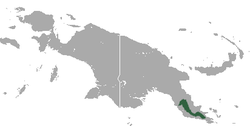Rothschild New Guinea bag mouse
| Rothschild New Guinea bag mouse | ||||||||||||
|---|---|---|---|---|---|---|---|---|---|---|---|---|

Preparation of the Rothschild New Guinea pouch mouse |
||||||||||||
| Systematics | ||||||||||||
|
||||||||||||
| Scientific name | ||||||||||||
| Murexia rothschildi | ||||||||||||
| ( Tate , 1938) |
The Rothschild New Guinea bag mouse ( Murexia rothschildi , Syn .: Paramurexia rothschildi ) is a bag mammal from the family of predatory mammals (Dasyuridae). The type epithet honors the English zoologist Walter Rothschild .
features
The 10 type specimens that were caught in the 1930s and 1950s have a head-torso length of 124 to 170 mm, a tail length of 140 to 184 mm, a hind foot length of 25 to 34 mm, an ear length of 13 to 21.5 mm and a weight of 32 to 102 g. The upper side is dull light gray and is characterized by a black eel line, which is the widest stripe on the back of all pouch mice . The underside is light brown. The smooth coat is short and dense. The females have four teats.
distribution and habitat
Occurrences are known from the Aroa River, Mount Simpson, Mount Mura and the regions of Opanabu and Agaun in the Milne Bay Province in southeastern New Guinea. The species inhabits hilly forests and old, montane wet forests at altitudes between 600 and 1,400 m.
Way of life
The way of life of the Rothschild New Guinea bag mouse has so far been little researched. The species is ground-dwelling, but also adapted to climbing. It is mostly nocturnal and lives in underground nests during the day. The females presumably give birth all year round and give birth to up to four young. The diet consists of beetle larvae and birds, among other things.
Systematics
The Rothschild New Guinea bag mouse was placed in the genus Phascogale (subgenus Murexia ) when it was first described. In 2002 Steve van Dyck classified it in the monotypical genus Paramurexia on the basis of cladistic analyzes . However, genetic studies support a monophyly of all New Guinea bag mice , all of which are now placed in the genus Murexia .
status
The Rothschild New Guinea bag mouse is known of only 23 specimens. According to the IUCN , their population is considered endangered (vulnerable). The main threats come from habitat loss and hunting by hunting dogs. In addition, a planned nickel mine and oil palm plantations endanger the existence of the species.
Individual evidence
- ↑ Tate, GHH 1938: New or little known marsupials: A new species of Phascogalinae, with notes on Acrobates pulchellus Rothschild. Novitates Zoologicae, Vol. 41: p. 58-60.
- ^ Van Dyck, p. 2002: Morphology-based revision of Murexia and Antechinus (Marsupialia: Dasyuridae). Memoirs of the Queensland Museum 48: pp. 239-330.
- ^ Groves, CP 2005. Order Dasyuromorphia. In: DE Wilson and DM Reeder (eds.): Mammal Species of the World. Pp. 23-37. The Johns Hopkins University Press, Baltimore, Maryland, USA.
- ↑ Armstrong, LA, Krajewski, C. and Westerman, M. 1998: Phylogeny of the dasyurid marsupial genus Antechinus based on cytochrome-b, 12S-rRNA, and protamine-P1 genes. Journal of Mammalogy , Vol. 79: pp. 1379-1389.
- ↑ Andrew Baker: Family Dasyuridae (Carnivorous Marsupials). Pages 299 -30X in Don E. Wilson & Russell A. Mittermeier : Handbook of the Mammals of the World: Monotremes and Marsupials: Volume 5. ISBN 978-84-96553-99-6
literature
- Woolley, PA 2003. Reproductive biology of some dasyurid marsupials of New Guinea. In: ME Jones, CR Dickman and M. Archer (Eds.), Predators with Pouches: the Biology of Carnivorous Marsupials, CSIRO Publishing, Melbourne, Australia.
- Flannery, TF 1995. Mammals of New Guinea . 2nd Edition. Chatswood, New South Wales: Reed Books, 568 pp. ISBN 0-7301-0411-7
